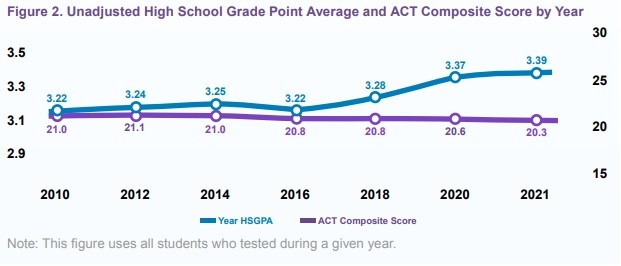More Proof Of Grade Inflation In Schools
A recent extensive study sheds more light into the growing trend of grade inflation among public schools across America.

Inflation is a popular word in America right now, but not just because of the rising costs of goods. On the education spectrum, grade inflation is also a big topic as of late. Grade inflation occurs when a student is given a higher grade point average (GPA) than they might deserve. In recent years, educators have brought more attention to this topic, as it appears to be occurring more and more. Now, a new report from ACT sheds more light on this growing trend happening in schools.

The nonprofit organization known as ACT, which administers the widespread college admissions standardized tests around the nation, released a new report on their findings of grade inflation in public schools. The thorough examination, published by Dr. Edgar I. Sanchez and Dr. Raeal Moore, finds more proof of grade inflation in high schools. The researchers studied GPA and ACT composite test scores from more than 4.3 million high school seniors’ from over 4,783 schools across the United States.
The study found that on average, high school GPAs increased by .19 grade points. In 2010, the students were averaging a GPA of 3.17. In 2021, that average rose to 3.36. More interestingly, between 2018 and 2021, grade inflation seemed to rise the most, despite the onset of the COVID pandemic that led to school closures, and heavily depicted learning losses. During this time, GPAs rose at their highest rate in ten years, gaining .1 GPA.
So what exactly correlates this data to grade inflation? A rise in average grades doesn’t necessarily mean that this practice is occurring, but given the state of education and a look into standardized test scores, something obviously doesn’t add up. As grades continued to increase, ACT composite scores continued to decline. In 2021, ACT test score averages reached their lowest level in the past decade. In 2010, the average test scores for the ACT were 21.40. By 2021, those scores went down to an average of 20.17.
So now that we have the data subjectively proving that grade inflation is occurring in schools in an accelerating manner, why is it happening, and how? To start, an extensive investigation from NPR over seven years ago points to a growing trend. This study found that districts across the U.S. were often mislabeling students, creating easier means for them to attain their high school diplomas.
The pandemic also holds a big clue as to why grade inflation is occurring at alarming rates. During this time, teachers were found to have altered the way they approached dishing out grades in order to allow more students to pass. Some districts took on a mindset that showed broad leniency for students who were missing instruction due to lack of internet access, or having to take care of sick family members at home during virtual learning. Some were even said to have handed out passing grades to otherwise failing students simply to deter a grade level “bloat” that could possibly occur if a mass amount of students were held back.
The evidence is out there, but not everyone agrees with the severity and impact grade inflation may have. Some experts believe it is a dire problem in education. Seth Gershenson, a professor for the American University thinks grade inflation can have lasting negative effects on the workforce, possibly misleading potential employers. But on the other hand, researchers like Zachary Bleemer of Harvard downplay the effects, saying it has little impact other than positive ones like possibly boosting confidence among students. Either way, it definitely seems to be occurring, and only in an increasing matter.



